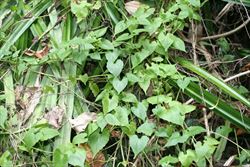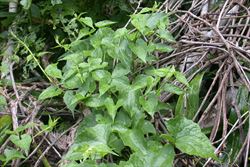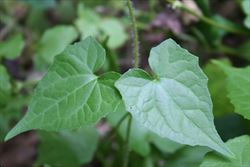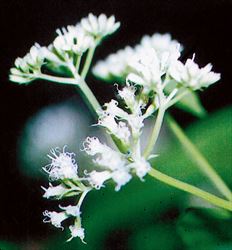Click on images to enlarge

habit (Photo: Land Protection, QDNRW)

habit (Photo: Land Protection, QDNRW)

habit (Photo: Simon Brooks)

leaves (Photo: Simon Brooks)

leaves (Photo: Simon Brooks)

close-up of leaves (Photo: Land Protection, QDNRW)

close-up of flowers (Photo: Land Protection, QDNRW)

close-up of seeds (Photo: Land Protection, QDNRW)
Scientific Name
Mikania micrantha Kunth
Family
Asteraceae (Queensland, New South Wales, the ACT, Victoria, Tasmania, Western Australia and the Northern Territory)Compositae (South Australia)
Common Names
American rope, bitter vine, bittervine, Chinese creeper, climbing hemp vine, climbing hempvine, climbing hempweed, mikania, mikania vine, mile a minute, mile a minute weed, mile-a-minute, mile-a-minute weed
Origin
Native to Mexico, Central America (i.e. Belize, Costa Rica, El Salvador, Guatemala, Nicaragua and Panama), the Caribbean (i.e. Cuba, Dominica, Grenada, Guadeloupe, Martinique and St. Lucia) and tropical South America (i.e. French Guiana, Guyana, Surinam, Venezuela, Brazil, Bolivia, Colombia, Ecuador, Peru and Argentina).
Naturalised Distribution
This species is not yet widely naturalised in Australia. It has only been recorded from a few locations in the coastal areas of northern Queensland (e.g. Speewah, Mission Beach, Ingham and Kuranda) and on Christmas Island.
Also naturalised in tropical Asia (e.g. India, Nepal, Bangladesh, Sri Lanka, China, Indonesia, Malaysia, Brunei, the Philippines, Singapore, Thailand and Papua New Guinea), the Mascarenes (e.g. Mauritius), Melanesia, Polynesia and Hawaii.
Habitat
A potential weed of wetter habitats in the tropical and sub-tropical regions of Australia. This species invades disturbed forests, forest margins, waterways, roadsides, pastures, plantations and some crops.
Habit
A fast-growing, much-branched, and long-lived (i.e. perennial) vine with a climbing, twining or creeping habit. Its stems can grow up to 6 m or more long.
Distinguishing Features
- a long-lived vine with slender ribbed stems and oppositely arranged leaves.
- its leaves are heart-shaped or somewhat triangular, hairless, and have coarsely toothed margins.
- numerous fluffy white flower-heads are borne in branched clusters in the leaf forks or at the tips of the branches.
- the tiny black seeds (1.5-2 mm long) are topped with numerous whitish coloured hairs or bristles (2-4 mm long).
Stems and Leaves
The slender stems are ribbed lengthwise (i.e. longitudinally) and are either hairless (i.e. glabrous) or slightly hairy (i.e. puberulent). These stems sometimes produce roots (i.e. adventitious roots) at their joints (i.e. nodes).
The leaves are oppositely arranged (4-13 cm long and 2-9 cm wide) and either heart-shaped (i.e. cordate) or somewhat triangular in shape with a long pointed tip (i.e. acuminate apex). These leaves are borne on stalks (i.e. petioles) 2-8 cm long, are hairless (i.e. glabrous), and have coarsely toothed (i.e. dentate or crenate) margins.
Flowers and Fruit
Numerous fluffy flower-heads (i.e. capitula) are borne in branched clusters originating in the forks of the leaves or forming at the tips of the branches (i.e. in axillary or terminal corymbs). These flower-heads (i.e. capitula) are small (3-6 mm long) and white or greenish-white in colour. They do not have any obvious petals (i.e. they have no ray florets) and consist of four tiny flowers (i.e. tubular florets), each 3-4 mm long, surrounded by a row of four small green bracts (i.e. involucre). These bracts (2-4 mm long) are oblong to egg-shaped in outline (i.e. obovate) with pointed tips (i.e. acute apices). Flowering occurs mostly from late autumn through to early spring.
The tiny black or blackish-brown 'seeds' (i.e. achenes) are elongated (i.e. linear-oblong) in shape and five-angled in cross-section. These seeds (1.2-2 mm long and 0.2-0.6 mm wide) are topped with a ring (i.e. pappus) of numerous (30-38) whitish coloured hairs or bristles (2-4 mm long).
Reproduction and Dispersal
This species reproduces by seeds and also vegetatively via stem fragments that can readily develop into new plants.
The seeds are generally spread by wind, or become attached to animals and clothing. Stem fragments can be dispersed to new areas in dumped garden waste, during cultivation practices, and during floods.
Environmental Impact
Mikania vine (Mikania micrantha) is regarded as a potentially significant environmental weed in northern Queensland, and in other parts of northern Australia. It was recently listed as a priority environmental weed in at least one Natural Resource Management region and appears on the Northern Australia Quarantine Strategy (NAQS) list.
Becuase of its invasiveness in other parts of the world, mikania vine (Mikania micrantha) is also listed in the Global Invasive Species Database, and is regarded to be in the top 100 of the world's worst invasive alien species.
Legislation
This species is declared under legislation in the following states and territories:
- Northern Territory: C - not to be introduced into the Territory.
- Queensland: Class 1 - introduction into the state is prohibited, and landowners must take reasonable steps to keep land free of this species (throughout the entire state). It is also illegal to sell a declared plant or its seed in this state. This declaration also applies to all mikania species (i.e. Mikania spp.).
- Western Australia: Prohibited - on the prohibited species list and not permitted entry into the state.
Management
For information on the management of this species see the following resources:
- the Biosecurity Queensland Fact Sheet on this species, which is available online at http://www.dpi.qld.gov.au.
Similar Species
Mikania vine (Mikania micrantha) is reasonably similar to several other vines including the climbing groundsels (Senecio angulatus and Senecio tamoides) and ivy groundsel (Delairea odorata) when not in flower. However, these species all have yellow flowers and are usually only found in sub-tropical and temperate regions.
It is also reasonably similar to the native headache vine (Clematis glycinoides), but on close inspection this species has leaves with three leaflets (i.e. trifoliate leaves) and its flowers have four petals.

